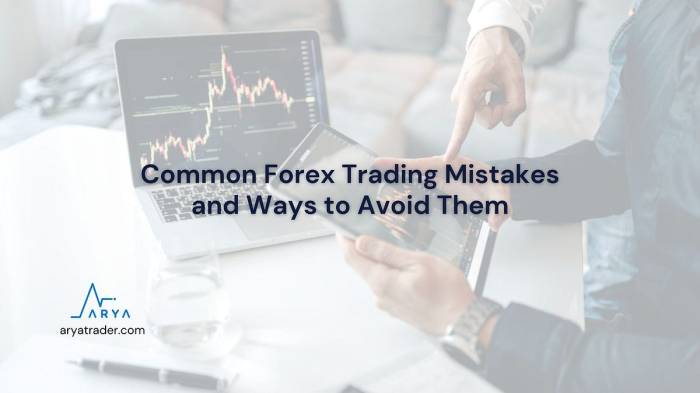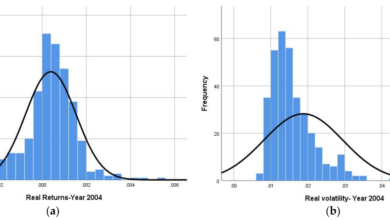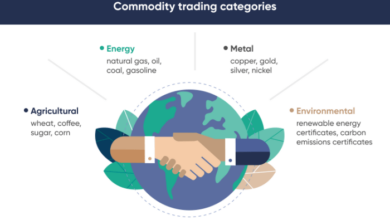
10 Common Forex Trading Mistakes to Avoid for Profitable Trading
10 common forex trading mistakes you must avoid for profitable trading – The allure of forex trading, with its promise of potential riches, can be intoxicating. However, the path to consistent profitability is paved with pitfalls. ’10 Common Forex Trading Mistakes to Avoid for Profitable Trading’ highlights critical errors that can derail even the most seasoned trader.
Understanding these mistakes is the first step toward mastering this complex market and achieving your financial goals.
From neglecting a trading plan to succumbing to emotional biases, these mistakes can lead to substantial losses and erode confidence. This guide aims to equip you with the knowledge and strategies to navigate these pitfalls, ensuring you make informed decisions and maximize your chances of success.
Lack of a Trading Plan

A trading plan is an essential tool for any forex trader, regardless of experience level. It acts as a roadmap, guiding your trading decisions and helping you stay disciplined and focused. Without a plan, you’re essentially navigating the forex market blindly, increasing the likelihood of making impulsive decisions driven by emotions rather than sound strategy.A well-defined trading plan helps you manage risk and emotions effectively.
It Artikels your trading goals, risk tolerance, and specific strategies, allowing you to approach the market with a clear and consistent mindset. By adhering to your plan, you’re less likely to chase losses or succumb to the fear of missing out (FOMO).
Key Elements of a Trading Plan
A comprehensive trading plan should include the following key elements:
- Trading Goals: Define your specific trading objectives, such as profit targets, risk tolerance, and time horizon.
- Trading Strategy: Artikel your preferred trading style, whether it’s scalping, day trading, swing trading, or long-term investing. Detail the specific indicators, patterns, and technical analysis techniques you’ll use to identify trading opportunities.
- Risk Management: Determine your maximum risk per trade and establish a stop-loss order to limit potential losses. This is crucial for protecting your capital and preventing emotional decisions.
- Money Management: Define your position sizing and leverage strategy to manage your risk and maximize potential returns. This involves determining the percentage of your capital you’re willing to risk on each trade.
- Trading Journal: Keep a detailed record of your trades, including entry and exit points, profit or loss, and the reasoning behind each decision. This allows you to track your performance, identify areas for improvement, and analyze your trading patterns.
“A trading plan is like a compass. It guides you through the unpredictable waters of the forex market.”
Overtrading
Overtrading is a common mistake among forex traders, especially beginners. It involves placing too many trades, often without proper analysis or risk management. This can lead to significant losses and erode your trading capital quickly.
Understanding the Risks of Overtrading
Overtrading poses several risks to your trading success. Here’s a breakdown:
- Increased Risk of Losses:Each trade carries inherent risk. Overtrading exposes you to more potential losses, making it difficult to recover from negative streaks.
- Emotional Trading:Overtrading often stems from impatience and a desire to make quick profits. This can lead to impulsive decisions based on emotions rather than sound analysis, increasing the likelihood of mistakes.
- Reduced Trading Efficiency:When you trade too frequently, you may not have enough time to properly analyze opportunities and manage your trades effectively. This can lead to rushed decisions and missed opportunities.
- Higher Transaction Costs:Frequent trading increases brokerage fees and spreads, eating into your profits.
- Stress and Fatigue:Constant monitoring of multiple trades can be stressful and lead to fatigue, affecting your judgment and trading performance.
Strategies to Identify and Avoid Overtrading, 10 common forex trading mistakes you must avoid for profitable trading
Here are some strategies to help you identify and avoid overtrading tendencies:
- Establish a Trading Plan:A well-defined trading plan with clear entry and exit points, risk management rules, and profit targets will help you stay disciplined and avoid impulsive trades.
- Set Realistic Trading Goals:Don’t chase unrealistic profits. Focus on consistent, sustainable gains over time. This will help you manage expectations and avoid overtrading.
- Limit the Number of Open Trades:Determine a maximum number of open trades you’re comfortable managing at any given time. This will help you avoid spreading your capital too thin and becoming overwhelmed.
- Track Your Trading Performance:Monitor your trading activity to identify patterns of overtrading. Analyze your trades to understand why you’re overtrading and how to address it.
- Take Breaks:Stepping away from the markets allows you to refresh your mind and avoid emotional trading decisions.
Disciplined Trading vs. Overtrading
| Feature | Disciplined Trading | Overtrading |
|---|---|---|
| Trading Frequency | Selective, based on well-defined criteria | Frequent, often impulsive |
| Risk Management | Strict risk management rules in place | Lack of proper risk management |
| Profit Targets | Clearly defined profit targets | Chasing unrealistic profits |
| Emotional Control | Based on analysis and logic | Driven by emotions and impatience |
| Trading Performance | Consistent, sustainable gains | Erratic, prone to losses |
Ignoring Risk Management
In the unpredictable world of forex trading, risk management is not just an option but a crucial element for survival and long-term success. Without a robust risk management strategy, even the most skilled trader can fall victim to market fluctuations and suffer significant losses.
This section delves into the importance of risk management and explores techniques that can help you navigate the forex market with confidence.
Risk Management Techniques
Risk management in forex trading involves a set of strategies and techniques aimed at limiting potential losses while maximizing profit potential. This involves understanding the inherent risks of forex trading and taking proactive steps to mitigate them. Effective risk management strategies are essential for protecting your capital and ensuring long-term sustainability in your trading journey.
Stop-Loss Orders
A stop-loss order is a crucial tool for risk management in forex trading. It allows you to automatically exit a trade when the price reaches a predetermined level, limiting your potential losses. This order acts as a safety net, preventing your account from incurring excessive losses due to unexpected market movements.
Avoiding common forex trading mistakes is crucial for success, and understanding how inflation impacts your trading strategy is key. Inflation can significantly influence currency valuations, making it essential to stay informed about economic trends. For valuable insights on navigating the complexities of inflation, check out the inflation guide tips to understand and manage rising prices.
By incorporating this knowledge into your trading plan, you can better anticipate market movements and avoid costly errors, leading to more profitable trading outcomes.
For example, if you buy EUR/USD at 1.1000 and set a stop-loss order at 1.0950, your trade will automatically close when the price falls to 1.0950, limiting your loss to 50 pips.
Position Sizing
Position sizing is another vital risk management technique that involves determining the appropriate amount of capital to allocate to each trade. It ensures that you are not risking too much capital on a single trade, thereby protecting your account from significant losses.
A common rule of thumb is to risk no more than 1-2% of your total account balance on any single trade.
Impact of Risk Management Strategies
The table below illustrates the impact of different risk management strategies on potential losses:| Risk Management Strategy | Potential Loss ||—|—|| No Stop-Loss, Large Position Size | Significant Loss || Stop-Loss, Large Position Size | Limited Loss || No Stop-Loss, Small Position Size | Limited Loss || Stop-Loss, Small Position Size | Minimal Loss |As you can see, using a stop-loss order and a smaller position size significantly reduces potential losses.
This allows you to trade with greater confidence and avoid catastrophic losses that can derail your trading journey.
Trading on Emotions
Trading on emotions is a common mistake that can lead to significant losses. When emotions cloud your judgment, you’re more likely to make impulsive decisions that go against your trading plan.
Common Emotional Biases
Emotions can significantly impact trading decisions. Understanding common emotional biases that affect traders is crucial for mitigating their influence.
- Fear:Fear of missing out (FOMO) can lead to impulsive entries at unfavorable prices, while fear of loss can result in holding losing trades for too long, hoping for a recovery.
- Greed:Greed can lead to excessive risk-taking, chasing profits, and holding winning trades too long, potentially missing out on potential gains.
- Overconfidence:Overconfidence can lead to ignoring risk management rules and making overly aggressive trades, leading to significant losses.
- Revenge Trading:After experiencing a loss, traders might feel the need to “get even” by taking bigger risks, further increasing the potential for losses.
- Confirmation Bias:Confirmation bias leads to seeking information that confirms existing beliefs, ignoring evidence that contradicts them, and making biased trading decisions.
Managing Emotions During Trading
Managing emotions during trading is crucial for making rational decisions.
- Develop a Trading Plan:A well-defined trading plan helps you stick to your strategy and avoid emotional decisions. It should include entry and exit points, risk management rules, and profit targets.
- Practice Mindfulness:Mindfulness techniques can help you become more aware of your emotions and detach from them during trading. Techniques like deep breathing and meditation can help calm your mind and reduce emotional reactivity.
- Keep a Trading Journal:A trading journal helps you analyze your past trades and identify patterns in your emotional responses. This can help you understand your triggers and develop strategies for managing them.
- Take Breaks:When you feel overwhelmed or emotional, take a break from trading. This allows you to calm down and approach your trades with a clear mind.
- Seek Support:Talking to a trusted friend, family member, or professional can help you process your emotions and gain a different perspective on your trading decisions.
Insufficient Knowledge and Education
The forex market is vast and complex, demanding a deep understanding of its dynamics to navigate effectively. Jumping into trading without sufficient knowledge is akin to sailing a ship without a compass, leaving you vulnerable to unpredictable market forces.
Continuous learning is essential for long-term success in forex trading.
Essential Forex Trading Concepts
Every trader should possess a foundational understanding of core forex trading concepts. This knowledge serves as a compass, guiding your decisions and mitigating potential pitfalls.
- Currency Pairs:Forex trading involves exchanging one currency for another. Each currency pair represents the value of one currency against another, such as EUR/USD (Euro against US Dollar). Understanding the dynamics of these pairs is crucial for predicting price movements.
- Pip (Point in Percentage):The smallest unit of price change in a currency pair. Pips represent the profit or loss generated from a trade. A clear understanding of pip values is essential for accurate trade sizing and profit calculation.
- Lot Size:The volume of currency traded in a single transaction. Choosing the appropriate lot size is critical for managing risk and optimizing potential returns.
- Leverage:Forex trading allows traders to control larger positions with a smaller amount of capital. Understanding leverage is vital for maximizing profits but also managing risk effectively.
- Margin:The amount of money required to open and maintain a trade. Understanding margin requirements is crucial for avoiding margin calls and ensuring your trading capital remains secure.
- Technical Analysis:This method analyzes price charts and patterns to identify trading opportunities. Technical indicators, such as moving averages and MACD, provide valuable insights into market trends.
- Fundamental Analysis:This approach analyzes economic data and events that can influence currency values. Understanding economic indicators, such as GDP and inflation, can provide valuable insights into market sentiment.
- Risk Management:A crucial aspect of trading, risk management involves strategies to minimize potential losses and protect your capital. Essential tools include stop-loss orders and position sizing.
- Trading Psychology:Emotions can significantly impact trading decisions. Understanding your own biases and developing a disciplined approach is vital for avoiding impulsive actions.
Resources for Forex Education
The forex market offers a wealth of educational resources to enhance your trading knowledge.
- Online Courses:Numerous platforms provide comprehensive courses on forex trading, covering everything from basic concepts to advanced strategies. Look for courses from reputable providers with experienced instructors.
- Trading Books:A wide range of books offer in-depth insights into forex trading, covering various aspects, including technical analysis, fundamental analysis, and risk management.
- Trading Websites and Blogs:Numerous websites and blogs provide valuable information, analysis, and educational resources on forex trading. Look for websites with experienced traders and credible sources of information.
- Forex Forums and Communities:Engaging with other traders in online forums and communities can provide valuable insights and perspectives. However, always exercise caution and critical thinking when evaluating information shared in these forums.
Chasing Trends

Chasing trends in forex trading is a common mistake that can lead to significant losses. It involves entering a trade based solely on the assumption that a trend will continue without considering other factors. This can be particularly dangerous in volatile markets where trends can reverse quickly and unexpectedly.
Identifying Genuine Trends
Identifying genuine trends is crucial to avoid falling prey to false breakouts. Here’s how to do it:
- Use technical indicators:Moving averages, MACD, and RSI can help confirm the presence and strength of a trend.
- Look for price action confirmation:A trend is more likely to be genuine if it is supported by price action patterns like higher highs and higher lows in an uptrend or lower highs and lower lows in a downtrend.
- Consider market fundamentals:Economic news and events can influence trends. Understanding the underlying factors driving a trend can help you assess its sustainability.
Entering at the Peak vs. Waiting for a Pullback
Entering a market at the peak of a trend is risky because the trend is likely to reverse soon. Waiting for a pullback, on the other hand, offers a better entry point with a higher probability of success.
- Peak entry:High risk, potentially high reward, but the risk of a sudden reversal is significant.
- Pullback entry:Lower risk, potentially lower reward, but offers a better entry point with a higher probability of success.
Not Using Stop-Loss Orders
Stop-loss orders are an essential tool for managing risk in forex trading. They automatically exit a trade when the price reaches a predetermined level, preventing further losses. Without stop-loss orders, traders risk losing a significant portion of their capital if the market moves against their position.
Types of Stop-Loss Orders
Stop-loss orders come in different variations, each with its own purpose and application. Here are some common types:
- Market Stop-Loss Order:This type of order is executed at the next available market price, which can be significantly different from the desired stop price, especially during volatile market conditions. This can lead to larger losses than anticipated.
- Limit Stop-Loss Order:This order is only executed when the market price reaches the specified stop price or a better price. This helps traders minimize slippage and potential losses during market volatility.
- Trailing Stop-Loss Order:This order automatically adjusts the stop price as the market moves in the trader’s favor, locking in profits and minimizing potential losses. The trailing stop-loss order is typically set at a fixed percentage or number of pips away from the current market price.
Scenarios Where Stop-Loss Orders Can Protect Traders
Stop-loss orders can be crucial in protecting traders from significant losses in various scenarios:
- Unexpected Market Volatility:Stop-loss orders can help traders manage risk during unexpected market events, such as news releases, economic data announcements, or geopolitical events that can cause significant price fluctuations.
- Technical Breakouts:When a price breaks through a key support or resistance level, it can signal a trend reversal. Stop-loss orders can help traders exit positions before experiencing significant losses if the trend continues in the opposite direction.
- Overnight Gaps:The forex market operates 24 hours a day, 5 days a week. Overnight gaps can occur when there are significant price movements during the trading hours of other markets, such as the US or European markets. Stop-loss orders can help traders protect their positions from these overnight gaps.
“Stop-loss orders are like safety belts in a car. You may not need them most of the time, but they can save your life in an emergency.”
Unknown
Avoiding common forex trading mistakes is crucial for profitability, and understanding the global economic landscape plays a key role. While the IMF predicts resilient economic growth for India in FY23, as reported by The Venom Blog , it’s essential to stay informed about global trends and their potential impact on currency markets.
This includes staying disciplined with risk management, avoiding emotional trading, and constantly learning and adapting your strategies to navigate the ever-changing forex landscape.
Overleveraging: 10 Common Forex Trading Mistakes You Must Avoid For Profitable Trading
Overleveraging is a common mistake that forex traders make, often with disastrous consequences. It involves using excessive leverage, which can amplify both profits and losses. While leverage can be a powerful tool, it’s crucial to understand its potential risks and use it responsibly.
Leverage in Forex Trading
Leverage in forex trading allows traders to control a larger position in the market than their initial capital would allow. This is achieved by borrowing funds from a broker, which magnifies the potential returns on their trades. For example, if a trader has $1,000 and uses 100:1 leverage, they can control a position worth $100,000.
Benefits of Leverage
Leverage can be beneficial for forex traders, offering the following advantages:
- Increased Profit Potential:Leverage amplifies both profits and losses. This means that a small price movement in the market can result in a significant profit for the trader.
- Access to Larger Positions:Leverage allows traders to control larger positions with a smaller initial investment, making it possible to trade more efficiently and potentially generate higher returns.
- Improved Liquidity:Leverage can enhance liquidity by enabling traders to enter and exit positions quickly and easily, especially when dealing with large amounts of currency.
Risks of Leverage
While leverage offers potential benefits, it also carries significant risks:
- Amplified Losses:The same leverage that amplifies profits also amplifies losses. A small adverse price movement can quickly wipe out a trader’s entire account balance.
- Margin Calls:When a leveraged position moves against a trader, they may receive a margin call from their broker, requiring them to deposit additional funds to maintain the position. Failure to meet a margin call can result in the liquidation of the position.
Mastering forex trading involves avoiding common pitfalls that can derail your profits. One crucial aspect is understanding market sentiment and staying informed about major developments, like the recent news that the Senate’s most prominent advocate for cryptocurrency, known as the “Crypto Queen,” has unveiled a far-reaching new bill focused on Bitcoin here.
Such legislation can significantly impact market volatility, so staying ahead of the curve is vital. Remember, avoiding these common mistakes can help you navigate the forex market effectively and achieve your financial goals.
- Increased Risk of Overtrading:Leverage can encourage overtrading, as traders may feel tempted to take on more risk than they can afford. This can lead to significant losses and potentially even bankruptcy.
Impact of Leverage Levels on Potential Profits and Losses
The following table demonstrates the impact of different leverage levels on potential profits and losses for a $1,000 investment:
| Leverage | Potential Profit (1% Price Movement) | Potential Loss (1% Price Movement) |
|---|---|---|
| 10:1 | $100 | $100 |
| 50:1 | $500 | $500 |
| 100:1 | $1,000 | $1,000 |
| 200:1 | $2,000 | $2,000 |
Note:The table assumes a 1% price movement in the underlying currency pair. Actual profits and losses may vary depending on the specific leverage level, the size of the position, and the actual price movement.
Ignoring Market Analysis

Trading without a proper understanding of market movements is like driving a car blindfolded. You might get lucky once or twice, but it’s a recipe for disaster in the long run. Market analysis is the foundation of successful forex trading, providing insights into price trends, potential support and resistance levels, and overall market sentiment.
Fundamental Analysis
Fundamental analysis examines the economic, political, and social factors that influence currency values. It helps traders understand the underlying reasons for price movements and anticipate future trends. For instance, if a country’s central bank announces a surprise interest rate hike, it can strengthen its currency as investors become more attracted to its higher returns.
Key economic indicators like inflation, GDP growth, unemployment rates, and interest rates are crucial components of fundamental analysis.
Technical Analysis
Technical analysis focuses on historical price data and trading patterns to identify trends and predict future price movements. It utilizes various charts, indicators, and tools to analyze market sentiment, identify support and resistance levels, and spot potential buy or sell opportunities.
Popular technical indicators include moving averages, MACD, RSI, and Bollinger Bands, which provide signals based on price action and volume.
Examples of Market Analysis in Trading Decisions
Market analysis can guide trading decisions in several ways:
- Identifying potential entry and exit points:Technical analysis can pinpoint support and resistance levels, providing traders with potential entry points when prices bounce off support or exit points when they reach resistance.
- Confirming trading biases:Fundamental analysis can confirm or refute a trader’s initial trading bias based on economic news and events. For example, if a trader is bullish on a currency due to positive economic data, fundamental analysis can provide further evidence to support their decision.
- Managing risk:Market analysis can help traders identify potential risk areas and set appropriate stop-loss orders. By understanding market trends and support/resistance levels, traders can minimize potential losses.
Lack of Discipline and Patience
In the dynamic world of forex trading, discipline and patience are not mere virtues; they are essential tools for navigating the market’s volatility and achieving consistent profitability. Without these qualities, even the most sound trading strategies can falter, leading to impulsive decisions and potentially detrimental outcomes.
The Impact of Lack of Discipline
A lack of discipline can manifest in various ways, often leading to impulsive trading decisions that contradict a well-defined trading plan. This can include:
- Overtrading:Entering trades too frequently, driven by the urge to make quick profits, without proper analysis or consideration of risk.
- Ignoring Stop-Loss Orders:Failing to set or adhering to stop-loss orders, leading to significant losses when market movements go against the trader’s position.
- Chasing Trends:Entering trades late in a trend, hoping to catch the tail end of a move, often resulting in entering at unfavorable price points.
- Holding Losing Trades Too Long:Refusing to accept losses and exiting trades at a disadvantageous point, hoping for a rebound that may never materialize.
Strategies for Developing Discipline and Patience
Cultivating discipline and patience in forex trading requires a conscious effort and the implementation of specific strategies:
- Establish Clear Trading Rules:Define your entry and exit points, risk management parameters, and trading frequency. This provides a framework for making objective decisions.
- Practice Patience:Resist the urge to jump into every trading opportunity. Wait for setups that align with your trading plan and offer a favorable risk-reward ratio.
- Focus on the Long-Term:Remember that forex trading is a marathon, not a sprint. Focus on building consistent profits over time rather than chasing quick gains.
- Keep Emotions in Check:Avoid trading when you are feeling stressed, anxious, or overly excited. Emotional trading can lead to irrational decisions.
- Learn from Your Mistakes:Analyze your trading journal and identify patterns in your impulsive decisions. This helps you understand your weaknesses and work on improving your discipline.






